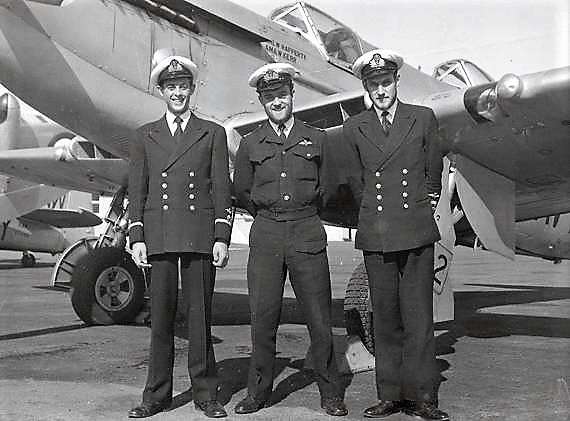Arthur Arundel was born on 29 November 1935 at Kingston Upon Hull, E Yorks. UK. He joined the Royal Navy (RN) on 17 February 1954. Details of his RN service are not available, but it is assumed he joined as a Midshipman Aircrew Trainee. After selection for pilot training he would have completed series of courses at a Flight Training School to gain his ‘wings’. On 27 January 1956, after graduating as a pilot he was promoted to Acting Sub-Lieutenant (P).
At the time there was an exchange program operating between the RN and RAN Fleet Air Arms, where junior aircrew were selected for further training and experience in the UK or Australia. In Arundel’s case, on 24 July 1956, he embarked on the Orient Line SS Otranto for passage to Australia, for a two-and-a-half year posting with the RAN FAA.
After arriving at Sydney in late August 1956, Arundel reported at HMAS Albatross (RANAS Nowra), for flying duties with 724 Squadron, the RAN’s main training squadron. His instructions were to gain experience flying Fairey Firefly anti-submarine aircraft. Initially this would have been under tutor in one of the Firefly Training aircraft – graduating to the standard Firefly AS5/6 aircraft which had separate cockpits for pilot and observer/navigator.
After gaining Firefly proficiency, on 21 October 1956, Arundel transferred to 851 Squadron to gain further operational experience. 851 Squadron was special training squadron that focussed on developing expertise in the anti-submarine role the Fireflies were designed for. This involved (among other things) long-distance patrols over the ocean, instrument flying, and working with the observer in plotting and identifying surface and underwater targets – in particular submarines.
Noel Francis Fogarty was born on 20 March 1936, at Chinchilla, Qld. On 1st April 1955, at Brisbane, he enlisted for six years in the Royal Australian Navy (RAN) as a Recruit Naval Airman (Air Crew). He arrived at HMAS Cerberus, Flinders Naval Depot (FND), south of Melbourne, on 5 April 1955, where he joined the Recruit School to begin Basic Training and to be assessed for air crew duties. At the end of the course he was rated Probationary Naval Airman (P).
On 19 July 1955, Fogarty was drafted to HMAS Watson, a depot on the South Head of Sydney Harbour, where he began short course before being posted, on 26 September 1955, to RAAF Uranquinty, joining the No1 Flying Training School. [At this point Fogarty’s records are badly faded or illegible]. After completing his RAAF training; on 15 March 1956 he was promoted Midshipman (Air Crew) and drafted to HMAS Cerberus for a Divisional Course, from 19 to 29 March.
Further instruction was conducted on the corvette training ship HMAS Gladstone, berthed at the FND wharf at Hann Inlet. The next move was to HMAS Penguin, a Sydney-based training depot, for an ABCD Course from 7 to 28 May 1956. Fogarty was then posted to HMAS Albatross (RANAS Nowra), the RAN Fleet Air Arm’s main air station, for observer training.
Upon arrival Fogarty would have joined 724 Squadron, the RAN’s primary training squadron at Nowra, with exercises conducted in the two-seater Fairey Firefly AS5/6 aircraft. The Firefly anti-submarine aircraft had a separate cockpit for the observer, offering a wide field of vision, radar, and other equipment necessary for hunting submarines. Much of the training involved long-range navigation patrols over the ocean and night flying exercises.

L-R: David Eagles, Arthur Arundel and Ian Ogilvy. No photograph of Noel Fogarty is currently available.
On 27 November 1956, at about 3 pm Acting Sub Lieutenant Arthur Arundel RN and Midshipman Noel Fogarty RAN were flying in Fairey Firefly WD887 on a navigation exercise approaching Jervis Bay, when at about 2,000 feet over the town of Huskisson it collided with another Firefly. Both young men were killed when their aircraft crashed into Jervis Bay. Despite lengthy searches their bodies were never found, and the wreckage of their aircraft remained hidden for many years.
The other Firefly, VX381, was badly damaged but managed to ditch into Jervis Bay, where it quickly sank. However, the pilot and observer managed to escape and were later winched to safety by a Sycamore helicopter from RANAS Nowra. In 1983 the wreckage of VX381 was discovered in about 15 metres of water and is now a popular dive site. More photographs and details of the search can be seen here.
Meanwhile, the location of WD887 remained unsolved until Nowra diver, Greg Stubbs, contacted the surviving pilot, David Eagles (then age 81) in the UK [Sub Lieutenant (P) Eagles, RN, at the time of the crash]. When Eagles visited Australia in 2016, he met Stubbs and narrowed-down the crash site of WD887. Stubbs then discovered the wreckage which had broken-up on impact and he vowed to place a commemorative plaque at the spot.
On Sunday, 27 November 2016, exactly 60 years after the crash that claimed the lives of Fogarty and Arundel, a memorial service was held on the waters of Jervis Bay, where Commodore Chris Smallhorn, RAN, Commander Fleet Air Arm said: ’When we lost those two young men, we lost two aviators that represented an entire Fleet Air Arm, an entire navy, an entire country’.
In a poignant remembrance of Fogarty and Arundel, a wreath was placed over the crash site, and with the help of Greg Stubbs and an RAN dive team, a granite plaque was positioned on the sea floor next to the remains of their aircraft.
Compiled by Kim Dunstan using the following References:
National Archives of Australia
Sea Power RAN FAA squadron histories
South Coast Register, 28 November 2016
Naval Daily, 8 December 2016


